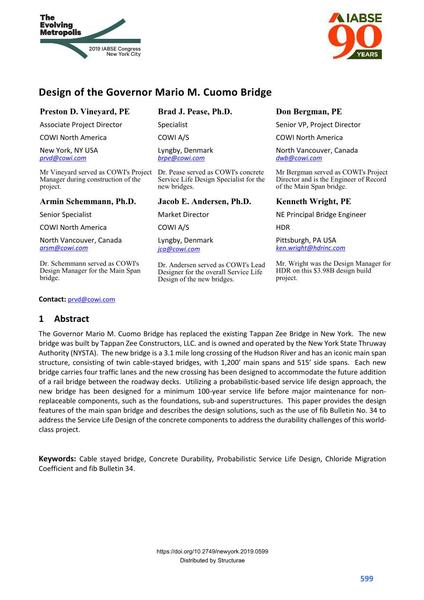Design of the Governor Mario M. Cuomo Bridge

|
|
|||||||||||
Bibliographic Details
| Author(s): |
Preston D. Vineyard
(COWI North America)
Brad J. Pease (COWI A/S) Don Bergman (COWI North America) Armin Schemmann (COWI North America) Jacob E. Andersen (COWI A/S) Kenneth Wright (HDR) |
||||
|---|---|---|---|---|---|
| Medium: | conference paper | ||||
| Language(s): | English | ||||
| Conference: | IABSE Congress: The Evolving Metropolis, New York, NY, USA, 4-6 September 2019 | ||||
| Published in: | The Evolving Metropolis | ||||
|
|||||
| Page(s): | 599-607 | ||||
| Total no. of pages: | 9 | ||||
| DOI: | 10.2749/newyork.2019.0599 | ||||
| Abstract: |
The Governor Mario M. Cuomo Bridge has replaced the existing Tappan Zee Bridge in New York. The new bridge was built by Tappan Zee Constructors, LLC. and is owned and operated by the New York State Thruway Authority (NYSTA). The new bridge is a 3.1 mile long crossing of the Hudson River and has an iconic main span structure, consisting of twin cable-stayed bridges, with 1,200’ main spans and 515’ side spans. Each new bridge carries four traffic lanes and the new crossing has been designed to accommodate the future addition of a rail bridge between the roadway decks. Utilizing a probabilistic-based service life design approach, the new bridge has been designed for a minimum 100-year service life before major maintenance for non- replaceable components, such as the foundations, sub-and superstructures. This paper provides the design features of the main span bridge and describes the design solutions, such as the use of fib Bulletin No. 34 to address the Service Life Design of the concrete components to address the durability challenges of this world- class project. |
||||
| Keywords: |
cable stayed bridge concrete Durability Probabilistic Service Life Design Chloride Migration Coefficient fib Bulletin 34
|
||||
